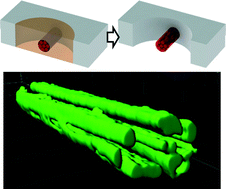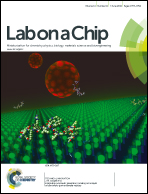Formation of elongated fascicle-inspired 3D tissues consisting of high-density, aligned cells using sacrificial outer molding†
Abstract
The majority of muscles, nerves, and tendons are composed of fiber-like fascicle morphology. Each fascicle has a) elongated cells highly aligned with the length of the construct, b) a high volumetric cell density, and c) a high length-to-width ratio with a diameter small enough to facilitate perfusion. Fiber-like fascicles are important building blocks for forming tissues of various sizes and cross-sectional shapes, yet no effective technology is currently available for producing long and thin fascicle-like constructs with aligned, high-density cells. Here we present a method for molding cell-laden hydrogels that generate cylindrical tissue structures that are ~100 μm in diameter with an extremely high length to diameter ratio (>100 : 1). Using this method we have successfully created skeletal muscle tissue with a high volumetric density (~50%) and perfect cell alignment along the axis. A new molding technique, sacrificial outer molding, allows us to i) create a long and thin cylindrical cavity of the desired size in a sacrificial mold that is solid at a low temperature, ii) release gelling agents from the sacrificial mold material after the cell-laden hydrogel is injected into fiber cavities, iii) generate a uniform axial tension between anchor points at both ends that promotes cell alignment and maturation, and iv) perfuse the tissue effectively by exposing it to media after melting the sacrificial outer mold at 37 °C. The effects of key parameters and conditions, including initial cavity diameter, axial tension, and concentrations of the hydrogel and gelling agent upon tissue compaction, volumetric cell density, and cell alignment are presented.


 Please wait while we load your content...
Please wait while we load your content...